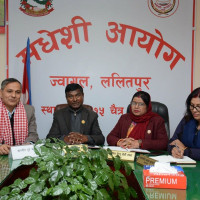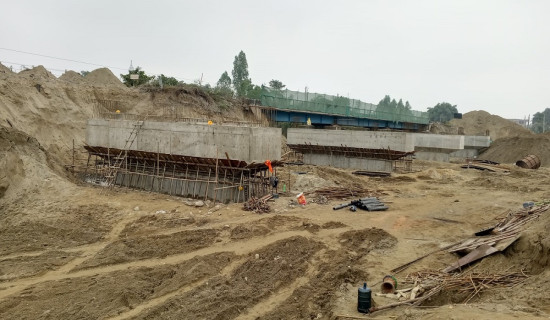- Thursday, 8 January 2026
China has lessons for Nepal in investment, agriculture
Beijing, Mar. 7: China has announced its national plan for 2024 with the economic growth target of 5 per cent and unveiled plans for boosting private investment - including the Foreign Direct Investment, and domestic consumption, promoting ‘high-quality development’, digital application in industrial sector, new-energy vehicles and increasing investment in research and development.
The new plan of China offers multiple solutions of socio-economic development to Nepal as the latter is in the process to formulate the budget for the upcoming Fiscal Year 2024/25. Particularly, China’s revolutionary strides and new plans in agriculture could be guiding lessons for Nepal.
The Chinese economy increased by 5.2 per cent in 2023 and reached US$ 17.5 trillion (126.06 trillion RMB). China has been working hard to boost the domestic demand in the wake of new challenges emerged in the international market including its ‘trade war’ with the USA.
Addressing the opening meeting of the second session of the 14th National People’s Congress (NPC) of China on Tuesday, Premier Li Qiang said that China would upgrade industrial and supply chains, foster future-oriented industries, promote innovative development of digital economy, boost consumer spending and build a unified national market.
According to him, China not only takes steps to unlock potential demand by increasing incomes, improving supply and reducing restrictions but also launches policies to promote digital, environment friendly and health related consumption. Li is also hopeful of fostering new areas of consumption growth like smart homes, entertainment, tourism, sports events and domestic brands with Chinese design elements.
Last year, China unveiled 17 measures to boost the private sector investment – they included new mechanism for public-private-partnership, participation of private enterprises in concession projects, development of national platform for opening up projects to private capital, and adjustment in the bank interest rates in the loan to the manufacturing industries. As a result, investment in high-tech industries rose by 10.3 per cent and manufacturing boosted by 6.5 per cent in 2023, Minister of Finance of China, Lan Fo’an, informed the press on Wednesday afternoon in Beijing.
Likewise, the government established multiple mechanisms for regular communication between the government departments and private enterprises, foreign-invested enterprises, state-owned enterprises, and manufacturing enterprises to take targeted measures for the development of the sector and address the constraints faced by the investors and businesses.
In the similar line, the government facilitated the establishment of a number of national demonstration parks for rural industrial integration and national modern agriculture industrial parks, and fostered 139 clusters of agro-industries. It certified additional 15,000 agricultural products as ‘green, organic and premium new products’.
“We will formulate and implement an action plan for upgrading quality, lowering costs, and expanding capacity in key manufacturing industries,” said Lan while adding that China wants to move the manufacturing sector toward higher-end, smarter, and greener production.
Since Agriculture is still the backbone of the national economy of Nepal, it should foster transition from agriculture to manufacturing by promoting agri-processing industries. The integrated development of agriculture not only spurs the development of processing industries but also creates opportunities in the businesses of cold stores, agri-machineries industries and suppliers, supply chain development and creates jobs in the rural areas. Lured by these benefits, last year alone, China guided the grain processing industries in upgrading their technologies and equipment, and facilitated the upgrading of more than 1,600 industrial parks for agri-processing.
For 2024, it has plan to accelerate the development of modern protected agriculture and intelligent agriculture, promote relay cropping and crop rotation, and develop an agricultural model of grain-grass intercropping and crop-livestock integration.
China also implemented programme and policies to boost employment and entrepreneurship for small and medium enterprises (SMEs) that apply special, sophisticated technologies to produce novel and unique products. This year, China is planning to execute human resource development programme that will enhance the capacity of workers of the SMEs and support the private sector in getting competent human resources. For this year, it plans to upgrade the vocational skills of about 1 million private enterprise employees.
Quite contrary, Nepal has failed for multiple times in executing programmes like development of human resources and establishment of training center for specific businesses like handicraft and textile.
Research and development has emerged as the one of the priority areas in China with the government allocation of about US$ 462 billion (3.33 trillion RMB). But Nepal doesn’t have working national plan for the development of science and technology and spends only about 110 million dollars on R&D.
Promotion of new energy vehicles is another priority of China. This is the sector in which China has achieved a significant success with such vehicles sales accounting for over 30 per cent of its total new vehicle sales last year. According to Zheng Shanjie, Chairman of the National Development and Reform Commission of China, the country exported 4.91 million new vehicles while electric vehicles, lithium batteries and photovoltaic products – known as ‘the new three’ – increased by close to 30 per cent.
Meanwhile, China is also planning to lift all restrictions on foreign investment in the manufacturing sector and relax market access restrictions in service industries including telecommunication and medical service. “We will facilitate people-to-people exchanges between China and the rest of the world, remove obstacles foreign citizens face in working, studying and traveling in China, and strive to realise full recovery in international air travel as soon as possible,” reads the draft report of China’s National Development and Reform Commission.












-original-thumb.jpg)



